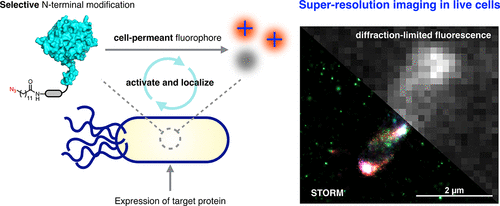当前位置:
X-MOL 学术
›
ACS Cent. Sci.
›
论文详情
Our official English website, www.x-mol.net, welcomes your
feedback! (Note: you will need to create a separate account there.)
Enzymatic Labeling of Bacterial Proteins for Super-resolution Imaging in Live Cells.
ACS Central Science ( IF 12.7 ) Pub Date : 2019-11-21 , DOI: 10.1021/acscentsci.9b00617 Samuel H Ho 1 , David A Tirrell 1
ACS Central Science ( IF 12.7 ) Pub Date : 2019-11-21 , DOI: 10.1021/acscentsci.9b00617 Samuel H Ho 1 , David A Tirrell 1
Affiliation

|
Methods that enable the super-resolution imaging of intracellular proteins in live bacterial cells provide powerful tools for the study of prokaryotic cell biology. Photoswitchable organic dyes exhibit many of the photophysical properties needed for super-resolution imaging, including high brightness, photostability, and photon output, but most such dyes require organisms to be fixed and permeabilized if intracellular targets are to be labeled. We recently reported a general strategy for the chemoenzymatic labeling of bacterial proteins with azide-bearing fatty acids in live cells using the eukaryotic enzyme N-myristoyltransferase. Here we demonstrate the labeling of proteins in live Escherichia coli using cell-permeant bicyclononyne-functionalized photoswitchable rhodamine spirolactams. Single-molecule fluorescence measurements on model rhodamine spirolactam salts show that these dyes emit hundreds of photons per switching event. Super-resolution imaging was performed on bacterial chemotaxis proteins Tar and CheA and cell division proteins FtsZ and FtsA. High-resolution imaging of Tar revealed a helical pattern; imaging of FtsZ yielded banded patterns dispersed throughout the cell. The precision of radial and axial localization in reconstructed images approaches 15 and 30 nm, respectively. The simplicity of the method, which does not require redox imaging buffers, should make this approach broadly useful for imaging intracellular bacterial proteins in live cells with nanometer resolution.
中文翻译:

细菌蛋白的酶促标记,用于在活细胞中进行超分辨率成像。
能够对活细菌细胞中的细胞内蛋白质进行超分辨率成像的方法为原核细胞生物学研究提供了强大的工具。可光转换的有机染料具有超分辨率成像所需的许多光物理特性,包括高亮度,光稳定性和光子输出,但是如果要标记细胞内靶标,则大多数此类染料都需要对生物进行固定和渗透。我们最近报道了使用真核生物酶N-肉豆蔻酰基转移酶在活细胞中用含叠氮化物的脂肪酸对细菌蛋白进行化学酶标记的一般策略。在这里,我们展示了使用细胞渗透双环壬炔功能化的光可开关若丹明螺内酰胺,在活大肠杆菌中标记蛋白质。对罗丹明螺内酰胺模型盐的单分子荧光测量表明,这些染料每次转换事件都会发射数百个光子。对细菌趋化蛋白Tar和CheA以及细胞分裂蛋白FtsZ和FtsA进行超分辨率成像。Tar的高分辨率成像显示出螺旋形图案;FtsZ的成像产生分散在整个细胞中的带状图案。重建图像中径向和轴向定位的精度分别接近15和30 nm。该方法的简便性,不需要氧化还原成像缓冲液,应使该方法广泛用于以纳米级分辨率对活细胞中的细胞内细菌蛋白进行成像。对细菌趋化蛋白Tar和CheA以及细胞分裂蛋白FtsZ和FtsA进行超分辨率成像。Tar的高分辨率成像显示出螺旋形图案;FtsZ的成像产生分散在整个细胞中的带状图案。重建图像中径向和轴向定位的精度分别接近15和30 nm。该方法的简便性,不需要氧化还原成像缓冲液,应使该方法广泛用于以纳米级分辨率对活细胞中的细胞内细菌蛋白进行成像。对细菌趋化蛋白Tar和CheA以及细胞分裂蛋白FtsZ和FtsA进行超分辨率成像。Tar的高分辨率成像显示出螺旋形图案;FtsZ的成像产生分散在整个细胞中的带状图案。重建图像中径向和轴向定位的精度分别接近15和30 nm。该方法的简便性,不需要氧化还原成像缓冲液,应使该方法广泛用于以纳米级分辨率对活细胞中的细胞内细菌蛋白进行成像。重建图像中径向和轴向定位的精度分别接近15和30 nm。该方法的简便性,不需要氧化还原成像缓冲液,应使该方法广泛用于以纳米级分辨率对活细胞中的细胞内细菌蛋白进行成像。重建图像中径向和轴向定位的精度分别接近15和30 nm。该方法的简便性,不需要氧化还原成像缓冲液,应使该方法广泛用于以纳米级分辨率对活细胞中的细胞内细菌蛋白进行成像。
更新日期:2019-12-27
中文翻译:

细菌蛋白的酶促标记,用于在活细胞中进行超分辨率成像。
能够对活细菌细胞中的细胞内蛋白质进行超分辨率成像的方法为原核细胞生物学研究提供了强大的工具。可光转换的有机染料具有超分辨率成像所需的许多光物理特性,包括高亮度,光稳定性和光子输出,但是如果要标记细胞内靶标,则大多数此类染料都需要对生物进行固定和渗透。我们最近报道了使用真核生物酶N-肉豆蔻酰基转移酶在活细胞中用含叠氮化物的脂肪酸对细菌蛋白进行化学酶标记的一般策略。在这里,我们展示了使用细胞渗透双环壬炔功能化的光可开关若丹明螺内酰胺,在活大肠杆菌中标记蛋白质。对罗丹明螺内酰胺模型盐的单分子荧光测量表明,这些染料每次转换事件都会发射数百个光子。对细菌趋化蛋白Tar和CheA以及细胞分裂蛋白FtsZ和FtsA进行超分辨率成像。Tar的高分辨率成像显示出螺旋形图案;FtsZ的成像产生分散在整个细胞中的带状图案。重建图像中径向和轴向定位的精度分别接近15和30 nm。该方法的简便性,不需要氧化还原成像缓冲液,应使该方法广泛用于以纳米级分辨率对活细胞中的细胞内细菌蛋白进行成像。对细菌趋化蛋白Tar和CheA以及细胞分裂蛋白FtsZ和FtsA进行超分辨率成像。Tar的高分辨率成像显示出螺旋形图案;FtsZ的成像产生分散在整个细胞中的带状图案。重建图像中径向和轴向定位的精度分别接近15和30 nm。该方法的简便性,不需要氧化还原成像缓冲液,应使该方法广泛用于以纳米级分辨率对活细胞中的细胞内细菌蛋白进行成像。对细菌趋化蛋白Tar和CheA以及细胞分裂蛋白FtsZ和FtsA进行超分辨率成像。Tar的高分辨率成像显示出螺旋形图案;FtsZ的成像产生分散在整个细胞中的带状图案。重建图像中径向和轴向定位的精度分别接近15和30 nm。该方法的简便性,不需要氧化还原成像缓冲液,应使该方法广泛用于以纳米级分辨率对活细胞中的细胞内细菌蛋白进行成像。重建图像中径向和轴向定位的精度分别接近15和30 nm。该方法的简便性,不需要氧化还原成像缓冲液,应使该方法广泛用于以纳米级分辨率对活细胞中的细胞内细菌蛋白进行成像。重建图像中径向和轴向定位的精度分别接近15和30 nm。该方法的简便性,不需要氧化还原成像缓冲液,应使该方法广泛用于以纳米级分辨率对活细胞中的细胞内细菌蛋白进行成像。











































 京公网安备 11010802027423号
京公网安备 11010802027423号